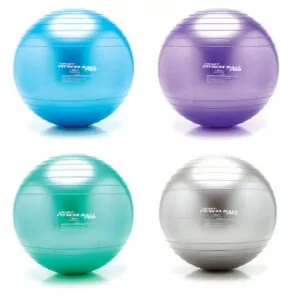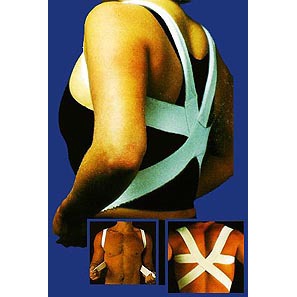Upper Back & Chest Pain Diagnosis Guide
Updated:
Patients suffering from upper back pain are commonly seen in physiotherapy practice particularly in sedentary individuals involved in computer work. Patients suffering chest pain, although less common, are also occasionally seen. Pain is usually caused by local structures within or around the upper back or chest, or, may occasionally be referred from other sources (such as the neck or upper back).
Sudden onset upper back and chest pain often occurs in individuals involved with heavy lifting, bending forward or twisting activities, or, combinations of these movements. It is also relatively common for patients to experience sudden onset upper back pain during a trivial bending movement such as picking up a pencil or during sneezing. These acute injuries usually involve tearing of connective tissue around the joints of the upper back and often have associated muscle spasm. One of the most common causes of sudden onset upper back pain with or without pain radiating into the arm, or chest is a Thoracic Disc Bulge (figure 1). Facet Joint Sprains are another common cause of sudden onset upper back pain (figure 2). In patients with sudden onset chest pain due to a direct blow to the chest, bruising or fracture of the ribs or sternum may be the cause of symptoms (see Rib Contusion, Rib Fracture or Sternal Fracture – figure 4).
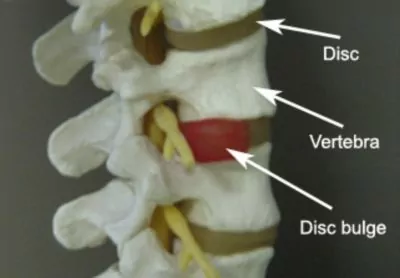
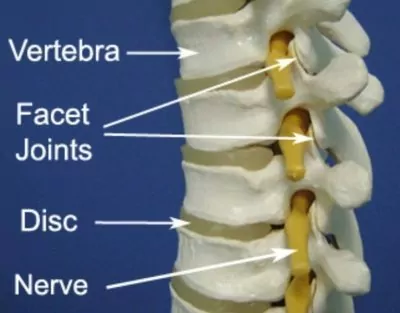
Gradual onset upper back and chest pain often occurs in those individuals involved in repetitive or prolonged bending, lifting, twisting or sitting activities (especially in poor posture e.g. sitting at a computer) or combinations of these activities. One of the most common causes of gradual onset upper back pain with or without pain radiating into the arm or chest is a Thoracic Disc Bulge (figure 1). In older patients with gradual onset upper back pain, one of the most likely causes of symptoms is degenerative changes in the spine (i.e. Spinal Degeneration).
There are numerous other causes of upper back and chest pain, some of which present suddenly due to a specific incident, others which develop gradually over time. In mature patients, chest or upper back pain originating from a cardiac issue (i.e. the heart), such as angina, is a possibility and must be ruled out by a doctor – particularly when other symptoms, such as shortness of breath, palpitations or a family history of heart disease are present.
Below are some of the more common causes of chest and upper back pain with a brief description of each condition to aid upper back and chest pain diagnosis. Conditions have been organised according to sudden or gradual onset and common or less common conditions for ease of use.
Find out what may be causing your upper back or chest pain:
Sudden Onset Upper Back & Chest Pain – Common Conditions
Thoracic Disc Bulge
Tearing of connective tissue surrounding a disc in the upper back with subsequent bulging of disc material (figure 1). One of the most common causes of upper back pain, typically as a result of bending, lifting, twisting or shoulders forwards activities or trivial movements, such as picking up a pencil or sneezing. May cause upper back pain with or without symptoms radiating along the ribs or into the chest, shoulder, arm, forearm, hand or fingers and often with associated muscle spasm. Pain may increase on firmly touching the affected level of the spine and spinal movement is often stiff or restricted. Occasionally there may be no upper back pain, with only symptoms along the ribs, in the chest or down the affected arm. Pins and needles or numbness are occasionally present in the chest or affected arm or hand. Symptoms often increase with repetitive or prolonged sitting (especially slouched sitting or during computer use), bending, lifting, shoulders forwards activities, coughing or sneezing and are often worse first thing in the morning.
Facet Joint Sprains
Tearing of connective tissue surrounding one of the joints located on either side of the spine (figure 2) typically as a result of excessive stretching of tissue usually during end of range bending, twisting, side bending, arching or lifting movements or combinations of these forces. Typically causes local upper back pain on one side of the spine that may increase on firmly touching the affected joint. Protective muscle spasm is often present.
Costovertebral Joint Sprain
Damage to connective tissue of one or more joints located adjacent to the spine, where the ribs attach to the vertebrae (costovertebral joint – figure 3) usually during end of range bending, twisting, side bending, arching or lifting movements or combinations of these forces. Typically causes one sided upper back pain that may occasionally radiate along the ribs as far as the chest. Pain may increase with certain movements of the spine (particularly rotation or side bending), during deep breathing, coughing or sneezing and on firmly touching the affected rib adjacent to its attachment to the spine (figure 3).

Referred Chest Pain
Pain referred to the chest from another source such as the upper back, frequently associated with symptoms in other areas such as the upper back, neck, along the ribs, or, into the shoulder or arm. Typically associated with pain on firmly touching the region responsible for the referred pain and / or loss of movement in that region. Sometimes in association with pins and needles or numbness in the upper back, chest, shoulder, arm or hand on the affected side of the body. Occasionally, chest pain may be referred from other structures within the body such as the heart, lungs or stomach, some of which may be due to serious conditions requiring immediate medical attention. These conditions may have other associated symptoms such as shortness of breath, heart palpitations, light headedness, etc. and may be more common in older patients or those with a family history of conditions such as heart disease.
Rib Contusion
Bruising of the ribs (figure 4) following a direct impact from an object or person. Typically associated with pain on firmly touching the affected region of the bone.
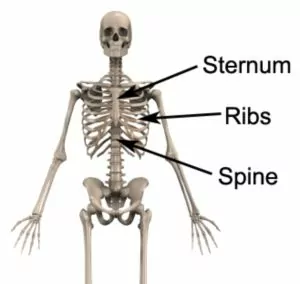
Less Common Sudden Onset Conditions
Rib Fracture
A break in one of the rib bones (figure 4) usually due to a traumatic direct impact from an object or person. Pain is usually severe and often increases with deep breathing, coughing, laughing or sneezing and on firmly touching the affected region of the rib. Pain may also increase when lying on the affected side or during certain upper back or shoulder movements.
Side Strain
Tearing to the muscle(s) between the ribs and pelvis on the side of the abdomen, usually following a high-force activity involving side bending or twisting of the spine, such as fast bowling (cricket) or throwing sports (e.g. javelin). Typically causes localised, one-sided upper abdominal pain that may occasionally radiate along the involved ribs. Pain may increase with certain movements of the spine (particularly rotation or side bending), when firmly touching the affected muscle and ribs and sometimes during deep breathing, coughing or sneezing.
Sternoclavicular Joint Sprain
Damage to connective tissue of the joint where one of the collar bones attaches to the sternum at the top of the chest (Sternoclavicular Joint – figure 5) usually due to a blow to the collar bone or shoulder. Typically causes upper chest pain, just beneath the neck and slightly to one side of the midline. Pain may increase with certain movements of the shoulder and on firmly touching the affected joint (figure 5).
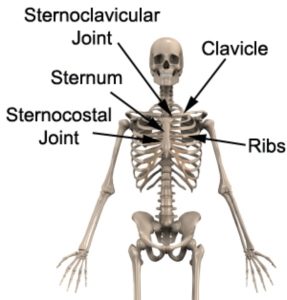
Sternocostal Joint Sprain
Damage to connective tissue of the joint where one of the ribs attaches to the sternum at the front / middle aspect of the chest (Sternocostal Joint – figure 5) usually due to a blow to one or more ribs. Typically causes chest pain, slightly to one side of the midline. Pain may increase with certain movements of the shoulder, during deep breathing, coughing, laughing or sneezing and on firmly touching the affected joint (figure 5).
T4 Syndrome
Damage to connective tissue surrounding one of the discs or facet joints (figure 2) located at the T4 level of the spine (figure 6) with subsequent irritation of adjacent nerves (figure 2). Typically occurs as a result of excessive bending, slouching, twisting, side bending, arching or lifting movements or combinations of these forces. Usually causes diffuse pain in the upper back or arm, with pins and needles or numbness in the upper arm. Pain may also increase on firmly touching the affected joint and protective muscle spasm is often present.
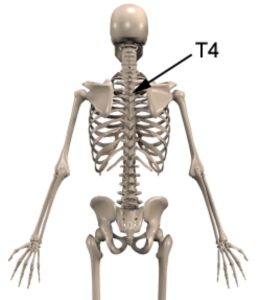
Sternal Fracture
A break in the breast bone (sternum – figure 5) usually due to a traumatic direct impact from an object or person to the front of the chest. Pain is usually severe and often increases with deep breathing, coughing, laughing or sneezing and on firmly touching the affected region of the bone. Pain may also increase when lying in certain positions such as on the side or stomach or during certain upper back or shoulder movements. Bruising, swelling and bony deformity may also be present.
Scheuermann’s Disease
An abnormality in bony growth of the upper back resulting in wedging of vertebrae (figure 2) and an increased curvature of the upper back. Most common in adolescents during a period of rapid growth and may cause upper back pain and stiffness. Some patients may experience no symptoms.
Intercostal Strain
Tearing to the muscle(s) between the ribs, usually following a high-force activity involving side bending or twisting of the spine, such as fast bowling (cricket) or throwing sports (e.g. javelin). Typically causes localised, one-sided chest pain that may occasionally radiate along the involved ribs. Pain may increase with certain movements of the spine (particularly rotation or side bending), during deep breathing, coughing or sneezing and on firmly touching the affected muscle and ribs.
Gradual Onset Upper Back & Chest Pain – Common Conditions

Members Only ContentBecome a PhysioAdvisor Member to gain full access to this exclusive content. For more details see Become a Member. Already a member? Login Now
Less Common Gradual Onset Conditions

Members Only ContentBecome a PhysioAdvisor Member to gain full access to this exclusive content. For more details see Become a Member. Already a member? Login Now
Upper Back & Chest Pain Diagnosis
A thorough subjective and objective examination from a physiotherapist is usually sufficient to diagnose the cause of chest and upper back pain. Investigations such as an X-ray, MRI, CT scan, bone scan and occasionally a blood test are often required to confirm diagnosis and rule out other conditions.
 Find a Physio
Find a Physio
Find a Physiotherapist in your local area who can assist with upper back and chest pain diagnosis and can treat patients suffering from chest and upper back injuries.
 More Information
More Information
- View Upper Back Stretches.
- View Pectoral Stretches.
- View Upper Back Strengthening Exercises.
- View Pectoral Strengthening Exercises.
- View Beginner Pilates Exercises.
- View Core Exercises.
- View detailed information on when to use Ice or Heat.
- View detailed information on initial injury management and the R.I.C.E Regime.
- View detailed information on Posture and Ergonomic Computer Setup.
- View detailed information on Safe Lifting.
- View detailed information on Posture Taping.
- View detailed information on a Return to Running Program.
 Physiotherapy Products for Upper Back and Chest Pain
Physiotherapy Products for Upper Back and Chest Pain
Some of the most commonly recommended products by physiotherapist for patients with chest and upper back injuries include:
To purchase physiotherapy products to assist with rehabilitation click on one of the above links or visit the PhysioAdvisor Shop.

Link to this Page
If you would like to link to this article on your website, simply copy the code below and add it to your page:
<a href="https://physioadvisor.com.au/injuries/upper-back-chest”>Upper Back & Chest Pain Diagnosis Guide – PhysioAdvisor.com</a><br/>We provide an upper back and chest pain diagnosis guide, created by experienced physiotherapists for patients suffering from upper back and chest injuries.
Return to the top of Upper Back & Chest Pain Diagnosis Guide.

